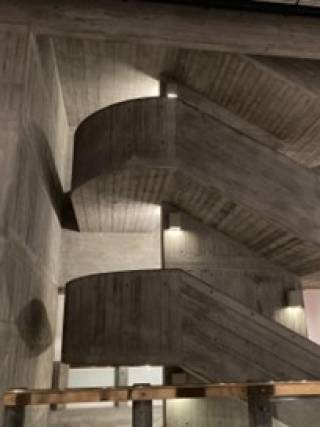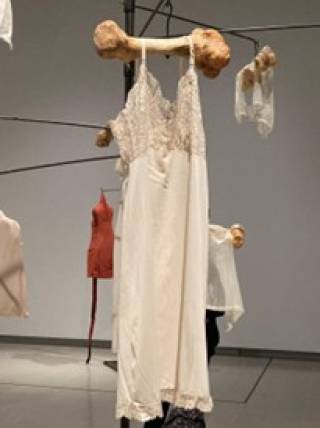Hayward Gallery’s ‘Louise Bourgeois: The Woven Child’ - art, textile and womanhood
29 June 2022
As part of our commitment to Equality, Diversity and Inclusion, we have appointed three student journalists to create compelling content which links Art History and EDI. In this article, student Andrea Petit reviews The Hayward Gallery’s ‘Louise Bourgeois: The Woven Child'.

The London art sphere is familiar with the Franco-American contemporary artist Louise Bourgeois, as for example one of her great towering spiders haunted Tate Modern’s Turbine Hall from 1999 to 2000. Yet, the Hayward Gallery’s show at Southbank Centre managed to present a new take of the multi-media artist’s extensive production, focusing on her later (and perhaps less famous) works. Louise Bourgeois: The Woven Child was on display from the 9th of February to the 15th of May 2022, establishing itself as the ‘first major retrospective’ of the artist’s fabric and textile works. In his filmed exhibition tour the head curator, and director of the Hayward Gallery, Ralph Rugoff explains that Louise Bourgeois only started really experimenting with textiles in her early 80s and continued until she passed away in 2010 at the age of ninety-eight. For reference, the tour is available on the gallery’s website, along with many other materials which give visitors an opportunity to further their experience and knowledge about the artist and exhibited pieces. (Find it here: https://www.southbankcentre.co.uk/whats-on/art-exhibitions/louise-bourgeois-woven-child?tab=blogs)
The exhibited works themselves come across as a personal (auto-) retrospective. Bourgeois seems to be looking back on her life as she tackles themes of birth, childhood, familial bonds, gender, woman and motherhood, and sexuality. The significance and defiance of these works being exhibited in an art institution is exacerbated by the spotlighted materials and techniques - such as sewing and recycled patchwork - which this review aims to highlight.

Fig. 1: Hayward Gallery room 1 concrete staircase.
I must admit this was my first visit to the Hayward Gallery since my arrival in London for my studies in 2019 - as the city is so full of places to visit - and my first time discovering Bourgeois’ works, which is hard to admit as I am French and expected to know every and all French artists (especially such a famous figure). So when I stepped into the first room with all other visitors, I was hit by the discovery of both the exhibition space and the works - bare concrete, white walls and sharp edges meeting fragile slip dresses, tree vestiges and beige cattle bones.
Her work Untitled (1996) from her Poles series showcases emotionally significant clothes from Bourgeois’ life which she decided to keep intact - as opposed to others used in her patchworks, dyeing processes and sculptures. Seven out of the eight hanging garments are canonically feminine white blouses or lace-adorned undergarments, often associated with intimacy, and feminine sexuality - layers that are only revealed in private. This first artwork therefore set the tone for a voyeuristic and slightly uncomfortable experience, the visitors being presented with ideas that push the traditional bounds of “museum-friendly” (or “museum-expected”). However, this is what makes Bourgeois’ work so striking and filled with raw “human-ness.”
Art often is a window into the soul of its creator; Louise Bourgeois used her work as a form of therapy and exploration of the self, alongside journaling and long years of psychoanalysis. Thus, Bourgeois being a woman, a daughter, wife and mother, many of her works are made up of the fabric of womanhood and its different facets or stages. Bourgeois tackles the theme of difficult childbirth and the hardships of motherhood/life in pieces such as The Woven Child (2003) and The Reticent Child (2003). These emotions and thoughts are taboo in Western society and rarely discussed, but Bourgeois graphically takes on these narratives. This show raised concepts such as the nude vs. the naked, which female-presenting bodies are art-like vs. pornographic or too ‘real’ to be considered subject of art. We may recall the Guerilla Girls’ provocative quote ‘do women have to be naked to get into the Met. Museum?’ Meaning, do women’s bodies have to be conventionally attractive, aesthetic, sexualised and posed to fit into the art category? In response, Bourgeois created visual testimonies which break the illusion of anomaly that entraps female bodies and their life experiences. With her sewn fabric figurines the artist creates supple bodies with honest human storylines, such partaking in sexual acts or birth-giving, scenes rarely found in art institutions.

Fig. 2: Louise Bourgeois’ nightgown in the Untitled (1996) Pole.
The techniques and materials the Hayward Gallery placed a focus on are crucial to the feminist reading of this exhibition. The works that were chosen presented an array of different materials and dimensions, from 2D fabric story books to human-sized steel, wood and glass cages. It made for a dynamic tour, with works beckoning the visitor to walk around the bigger installations, or closely observe a wall of textile prints in order to catch their intricacies.
The use of textile in each of these diverse pieces is what evokes the ongoing feminist discourse in art history. Here one may refer to the writing of Sigrid Wortmann Weltge, who, in studying the Bauhaus movement, reveals that textile was historically considered hierarchically inferior work in art and design because of its preconceived idea of being “women’s work.” Or again one may think of Griselda Pollock associating the image of the spinner in Bourgeois’ work to ‘tropes of femininity.’ In drawing upon these stereotypes and the material’s history, Bourgeois confronts discriminatory practices and solidifies women artist’s rightful place in art institutions.
As a last note, I was told by one of my fellow undergraduates - who wrote their dissertation on Bourgeois - that the exhibition was somewhat reductive as it did not account for the entirety of what Bourgeois represents because of its sole focus on her textile works. Ultimately, it may not have been the most comprehensive introduction to the figure of Bourgeois, but it did spark a deep interest in me and a willingness to learn more about her and her lifeworks. Her ideas are daring and unapologetically “woman,” broaching subjects that many often shy away from such as trauma, mental health, and sexuality. For newcomers, the show may serve as an intriguing first look into Bourgeois’ legacy; for connoisseurs, it presents a deeper exploration of a fragment of her work and showcases some of her ‘rarely seen major works.’
 Close
Close

